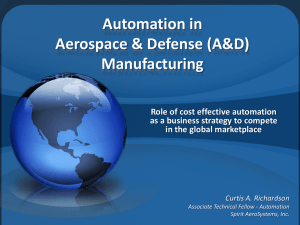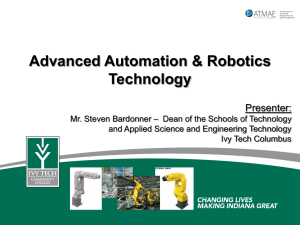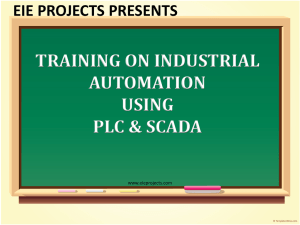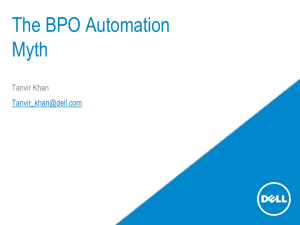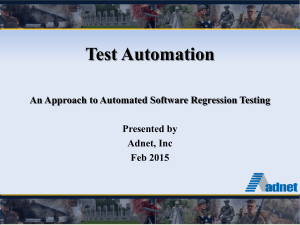Market leaders in the automation industry include Rockwell
advertisement
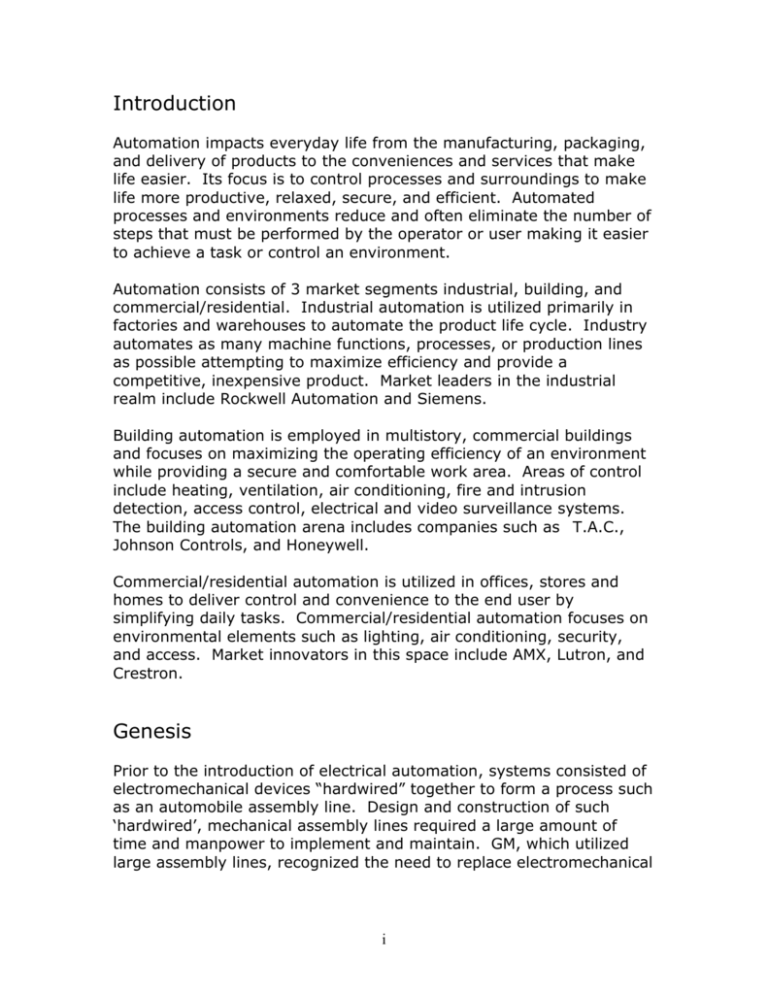
Introduction Automation impacts everyday life from the manufacturing, packaging, and delivery of products to the conveniences and services that make life easier. Its focus is to control processes and surroundings to make life more productive, relaxed, secure, and efficient. Automated processes and environments reduce and often eliminate the number of steps that must be performed by the operator or user making it easier to achieve a task or control an environment. Automation consists of 3 market segments industrial, building, and commercial/residential. Industrial automation is utilized primarily in factories and warehouses to automate the product life cycle. Industry automates as many machine functions, processes, or production lines as possible attempting to maximize efficiency and provide a competitive, inexpensive product. Market leaders in the industrial realm include Rockwell Automation and Siemens. Building automation is employed in multistory, commercial buildings and focuses on maximizing the operating efficiency of an environment while providing a secure and comfortable work area. Areas of control include heating, ventilation, air conditioning, fire and intrusion detection, access control, electrical and video surveillance systems. The building automation arena includes companies such as T.A.C., Johnson Controls, and Honeywell. Commercial/residential automation is utilized in offices, stores and homes to deliver control and convenience to the end user by simplifying daily tasks. Commercial/residential automation focuses on environmental elements such as lighting, air conditioning, security, and access. Market innovators in this space include AMX, Lutron, and Crestron. Genesis Prior to the introduction of electrical automation, systems consisted of electromechanical devices “hardwired” together to form a process such as an automobile assembly line. Design and construction of such ‘hardwired’, mechanical assembly lines required a large amount of time and manpower to implement and maintain. GM, which utilized large assembly lines, recognized the need to replace electromechanical i systems with a flexible, cost effective, reliable alternative as a means of staying competitive. In 1968, GM wrote the design criteria for the first programmable logic controller otherwise known as a PLC. One year later the first PLC was introduced on an assembly line heralding the automation industry as we know it today. Over time automation has migrated to industries ranging from health care, food and beverage, packaging/material handling, utilities (water/waste water management), security, entertainment (amusement park rides, Broadway productions). Recent trends show movement into the residential market. What is Automation? Automation is making an operation/process ‘automatic’ with the objectives of higher efficiency, greater flexibility, lower costs, improved quality and productivity. Initial automation systems, deployed for the automotive industry, were simple on/off devices controlled by a series of switches. These systems highlight the components that are the basis for all automation systems: inputs, outputs, and a logical or decision making unit. INPUTS Signals Decision Making/ Logical Unit Control OUTPUTS Motor Figure i. Basic components of Automation Systems An automation system, represented in Figure i, reads input signals from sensors which are fed to the logical or decision making unit. This logical unit, otherwise known as a programmable logic controller or PLC, makes decisions based on these input signals, resulting in the update of outputs. Updating an output can have two consequences: either a change of state or no change of state. For example, a change of state means the device connected to the output has changed from an ‘on’ state to an ‘off’ state or vice versa. No change in state means the device simply stays in the same mode of operation such as either ‘on’ or ‘off’. ii Technology improvements have led to smarter, less expensive automation solutions capable of handling far more complex processes. Additionally, systems are no longer limited to a single location but may be distributed across the world and connected via some form of data communication link such as a local area network or wireless communications. Innovation is leading to a still greater impact on industry as industrial machines are integrated with new information technologies, combining production, development, sales and management levels. A major contributor to innovation is the trend of moving away from proprietary or closed systems towards open systems. A proprietary system locks the customer into a limited vendor pool and is often subject to the whims of a small knowledge base. This leads to less innovation and no competition many times resulting in higher prices and stagnating technology. An open system is based on uniform industry standards allowing for the use of products from multiple vendors across a unified network. Open systems reduce cost, increase flexibility, and add greater choice. Automation System Types There are two types of Automation Systems: SCADA and DCS. SCADA or Supervisory Control and Data Acquisition Systems gather real time information to monitor and control the plant status for industries such as oil and gas, refining, water and waste management. The systems utilize centralized control and cover large geographic areas necessitating the use of a variety of communication systems to gather data from sensory points and issue commands to control points. The communications are typically less reliable and slow in comparison to a typical Local Area Network (LAN) configuration. Figure ii. Generic view of a control system. iii DCS or Distributed Control Systems are similar to SCADA but the sensory and control points are usually located in a more confined area. Communications may be via LAN and are normally high speed and very reliable. A true DCS system provides a centralized control that communicates with remote nodes operating independently. Each node has the capability to monitor and control a specific process while keeping the centralized control apprised of its progress. The centralized control acts as a communications point that allows the completed work from one remote node to be passed to the next in an orderly and timely manner. Roles The automation of any machine function, process, or production line is a complex, challenging, and stimulating process that requires a team effort from all involved. The primary participants are the customer, sales engineers, and engineering. Industrial Distribution graduates typically fill the role of, but are not limited to, sales engineering. Sales engineers visit the customer and are charged with identifying opportunities to deploy new products or improve existing automation solutions. These opportunities are conveyed to engineering by the sales engineer. The engineer proposes a solution to meet the customer and sales engineer’s expectations. When the customer accepts the proposal the sales engineer manages the communication channel between the customer and engineering. This requires a personable, creative individual, knowledgeable in the technical aspects of automation systems. iv



